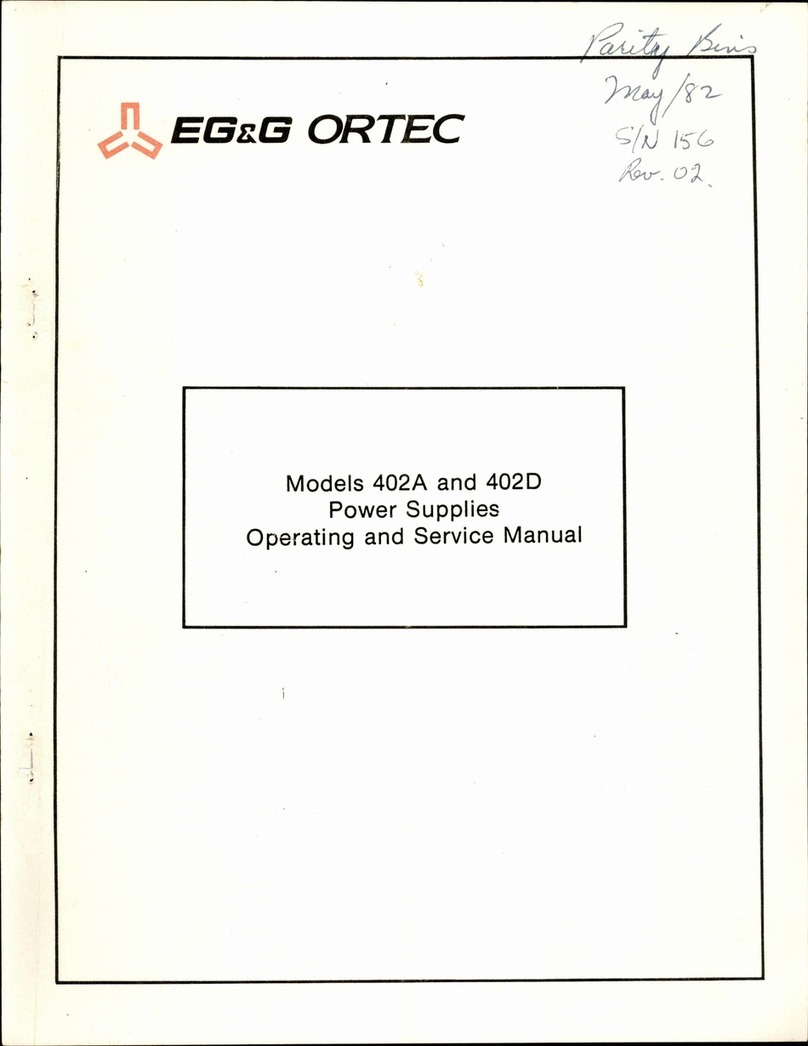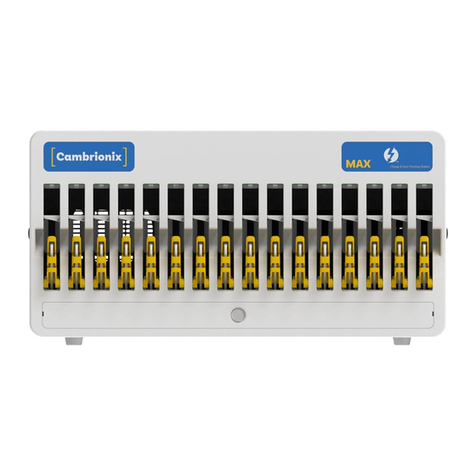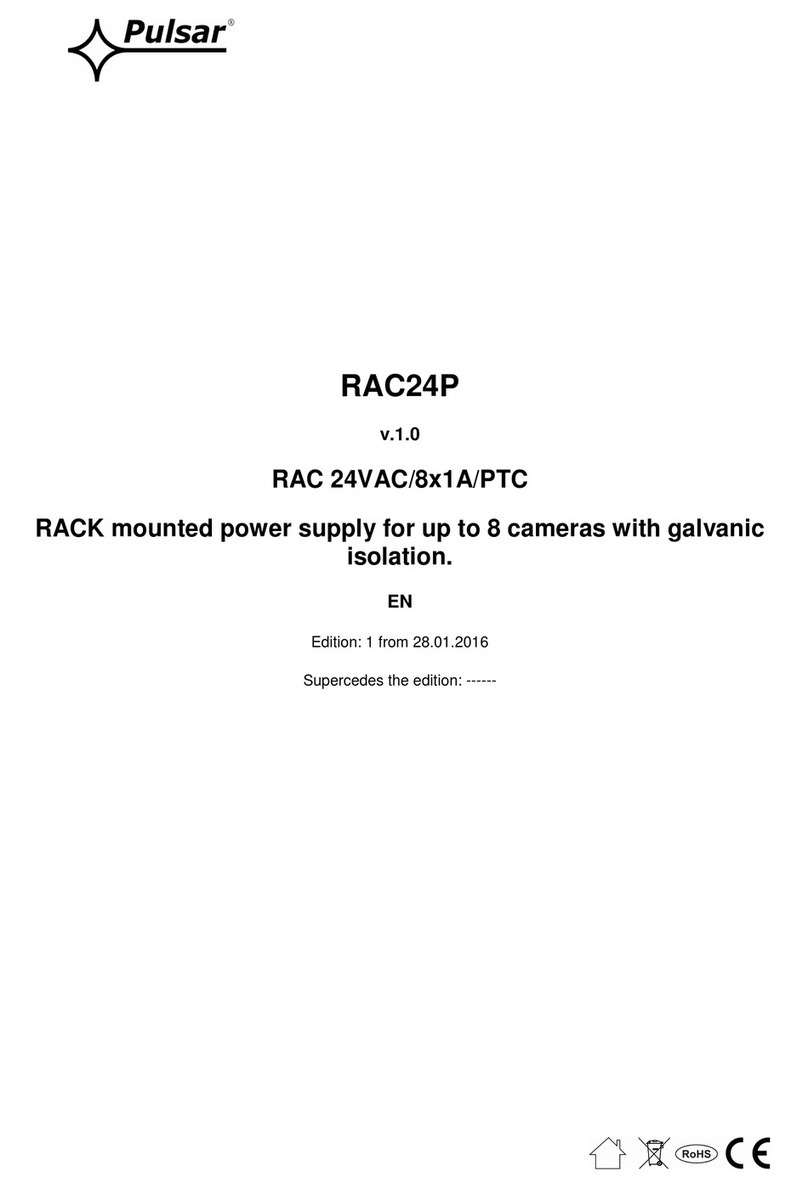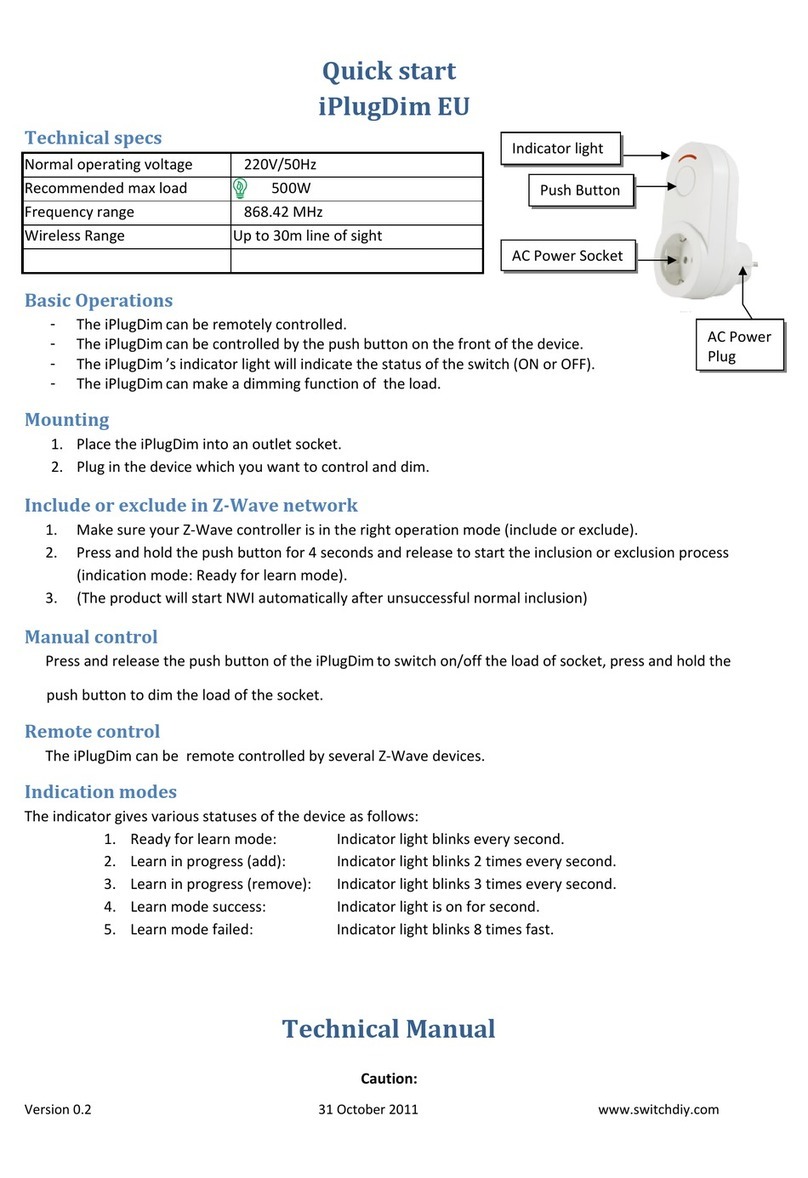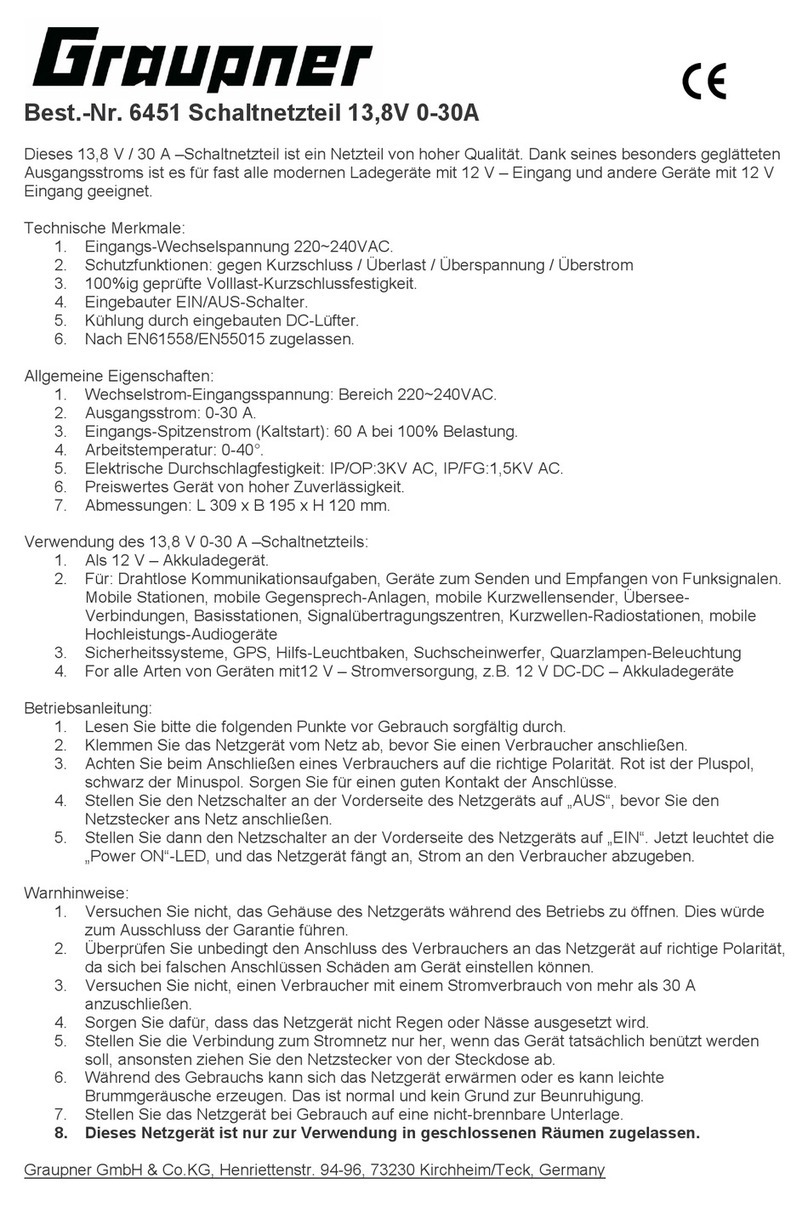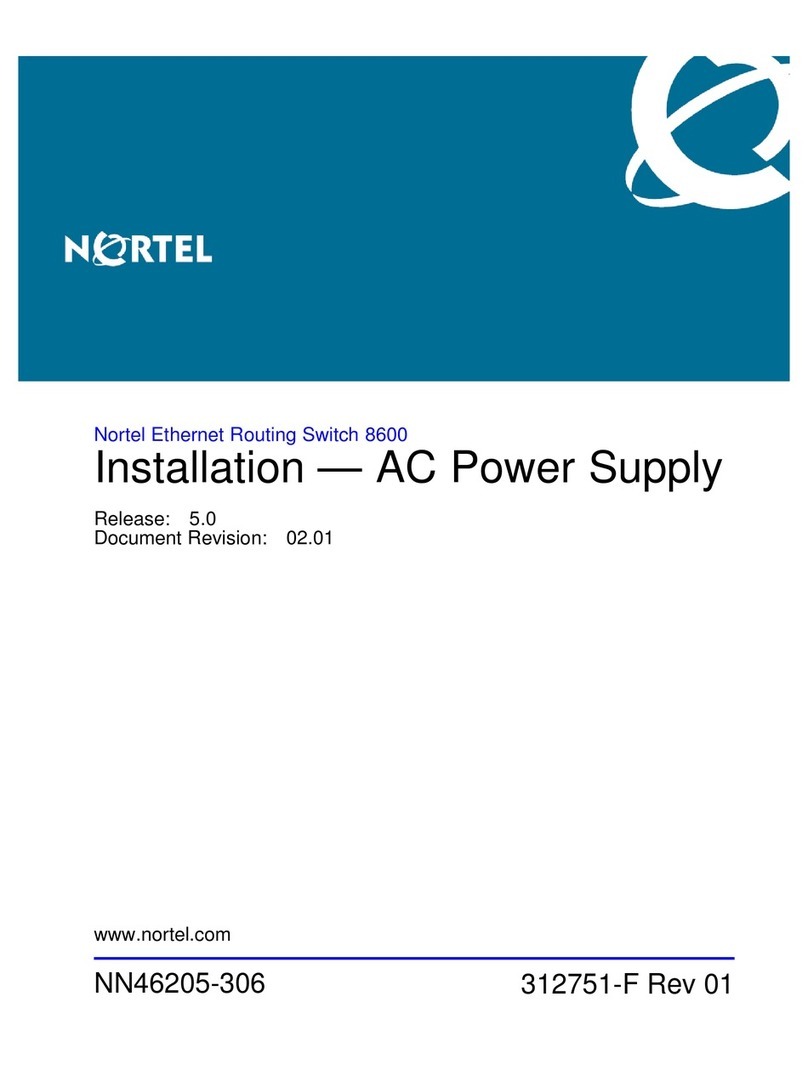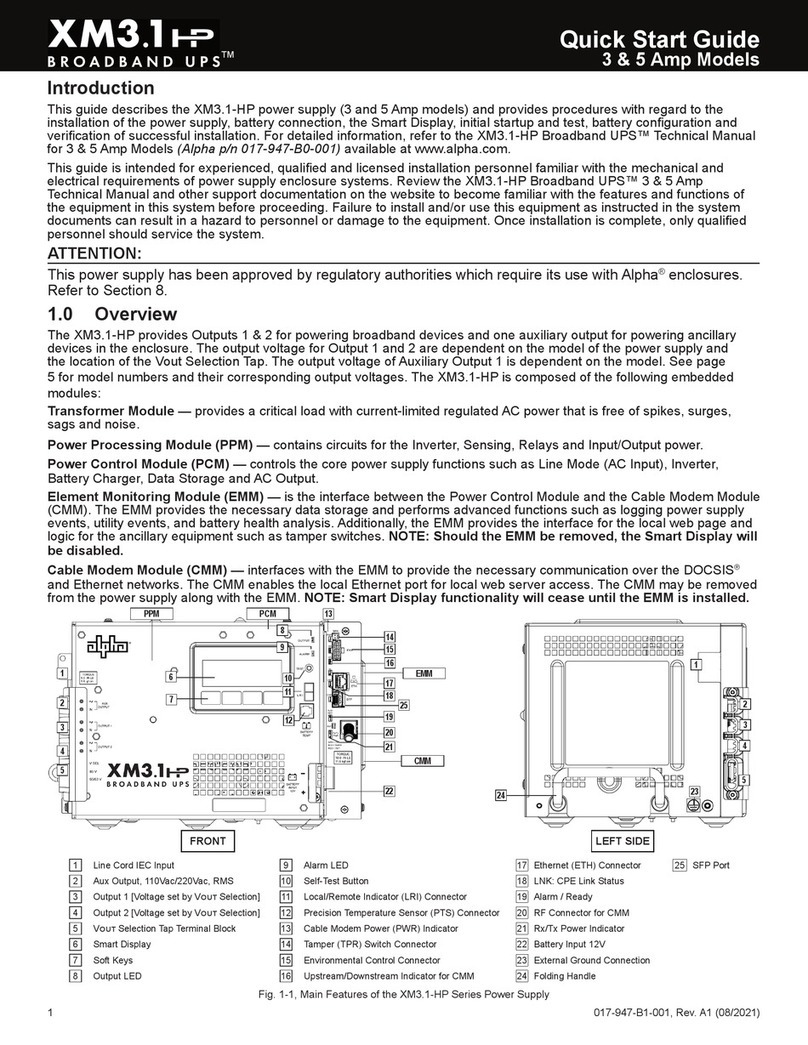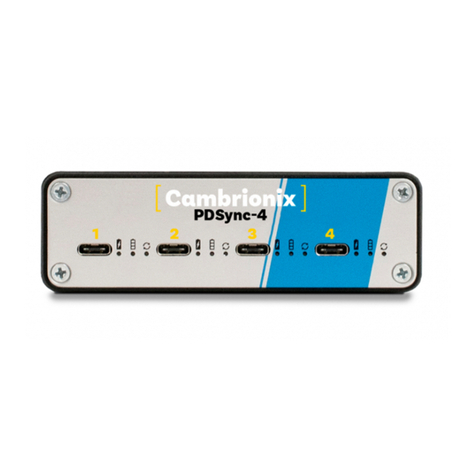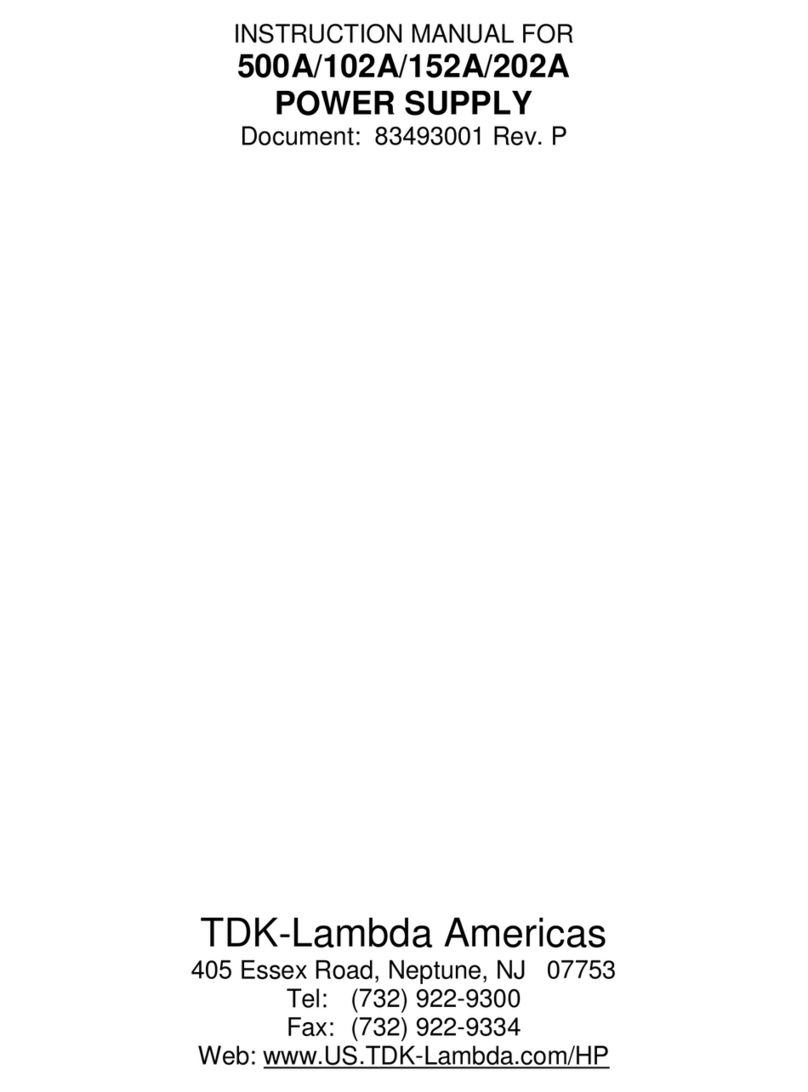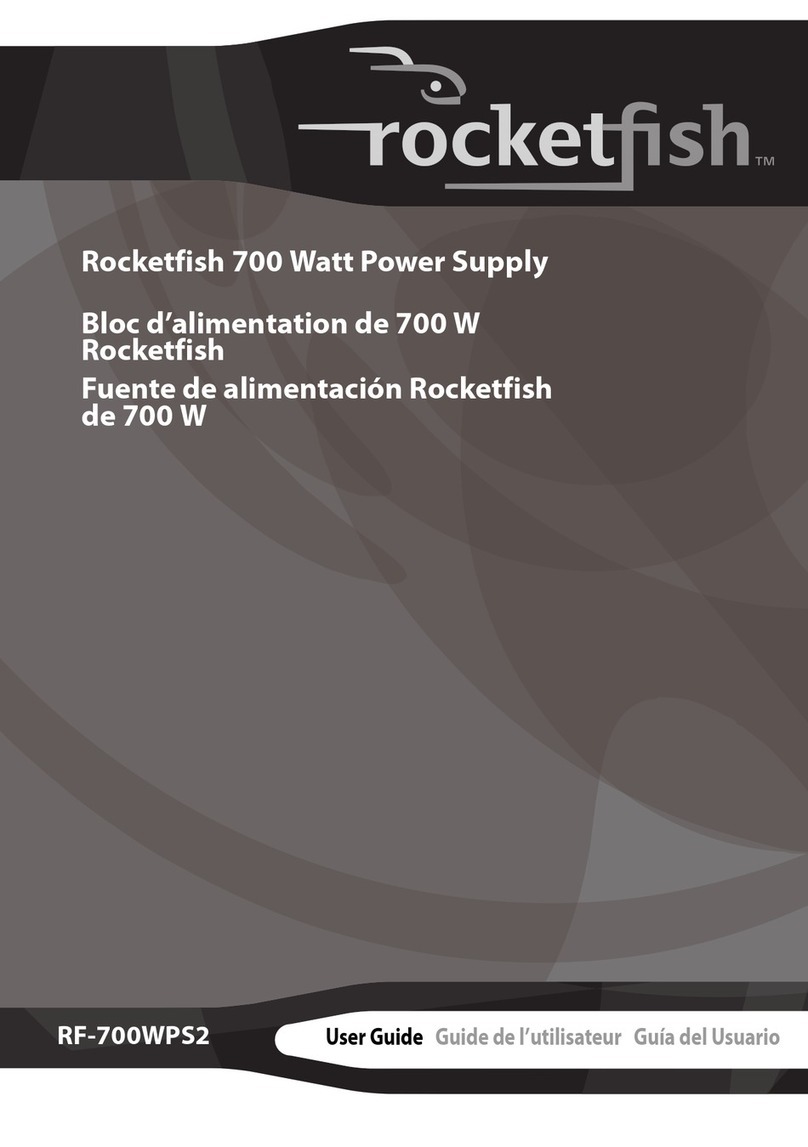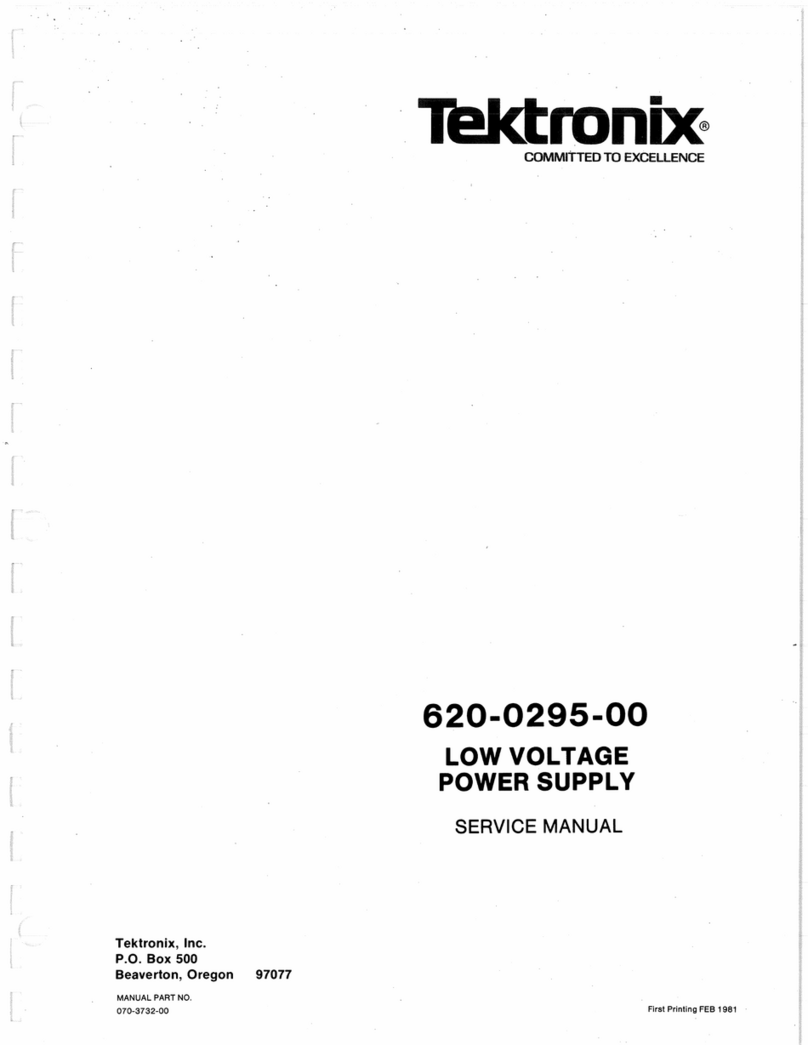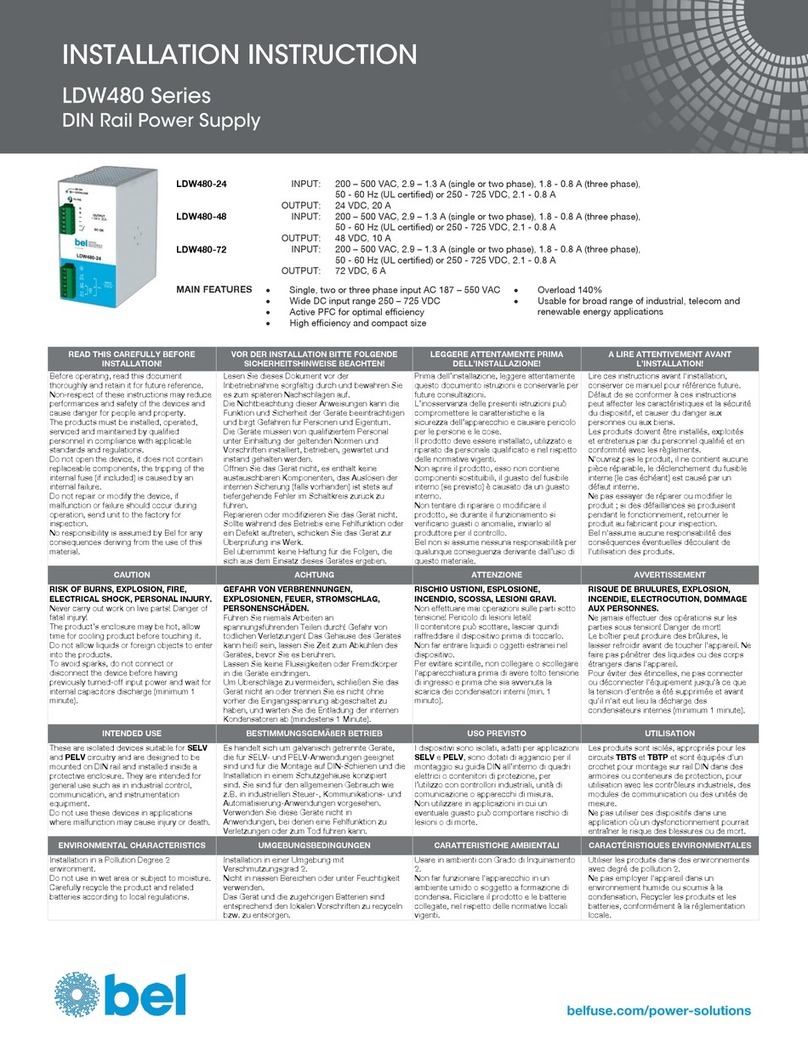EG&G ORTEC 4002A Service manual

n
Model
4002A
Power
Supply
Operating
and
Service
Manual

Model
4002A
Power
Supply
Operating
and
Service
Manual
This
manual
applies
to
instruments
marked
"Rev
18"
on
rear
panel
Printed
in
U.S.A.
^3''''

standard
Warranty
for
EG&G
ORTEC
Nuclear
Electronic
instruments
EG&G
ORTEC
warrants
that
the
items
will
be
delivered
free
from
defects
in
material
or
workmanship.
EG&G
ORTEC
makes
no
other
warranties,
express
or
implied,
and
specifically
NO
WARRANTY
OF
MERCHANTABILITY
OR
FITNESS
FOR
A
PARTICULAR
PURPOSE.
EG&G
ORTEC's
exclusive
liability
is
limited
to
repairing
or
replacing
at
EG&G
ORTEC's
option,
items
found
by
EG&G
ORTEC
to
be
defective
in
workmanship
or
materials
within
two
years
from
the
date
of
delivery.
EG&G
ORTEC's
liability
on
any
claim
of
any
kind,
including
negligence,
loss
or
damages
arising
out
of,
connected
with,
or
from
the
performance
or
breach
thereof,
or
from
the
manufacture,
sale,
delivery,
resale,
repair,
oruseof
any
item
or
services
covered
by
this
agree
ment
or
purchase
order,
shail
in
no
case
exceed
the
price
allocable
to
the
item
or
service
furnished
or
any
part
thereof
that
gives
rise
to
the
claim.
In
the
event
EG&G
ORTEC
fails
to
manufacture
or
deliver
items
called
for
in
this
agreement
or
pur
chase
order,
EG&G
ORTEC's
exclusive
liability
and
buyer's
exclusive
remedy
shall
be
release
of
the
buyer
from
the
obliga
tion
to
pay
the
purchase
price.
In
no
event
shall
EG&G
ORTEC
be
liable
for
special
or
consequential
damages.
Quality
Control
Before
being
approved
for
shipment,
each
EG&G
ORTEC
nuclear
electronic
instrument
must
pass
a
stringent
set
of
quality
control
tests
designed
to
expose
any
flaws
in
materials
or
workmanship.
Permanent
records
of
these
tests
are
maintained
for
use
in
warrany
repair
and
as
a
source
of
statistical
information
for
design
improvements.
Repair
Service
If
it
becomes
necessary
to
return
this
instrument
for
repair,
it
is
essential
that
Customer
Services
be
contacted
in
advance
of
its
return
so
that
a
Return
Authorization
Number
can
be
assigned
to
the
unit.
Also,
EG&G
ORTEC
must
be
informed,
either
in
writing,
by
telephone
[(615)
482-4411]
or
by
telex
(55-7450)
of
the
nature
of
the
fault
of
the
instrument
being
re
turned
and
of
the
model,
serial,
and
revision
("Rev"
on
rear
panel)
numbers.
Failure
to
do
so
may
cause
unnecessary
delays
in
getting
the
unit
repaired.
The
EG&G
ORTEC
standard
procedure
requires
that
instruments
returned
for
repair
pass
the
same
quality
control
tests
that
are
used
for
new-production
instruments.
Instruments
that
are
returned
should
be
packed
so
that
they
will
withstand
normal
transit
handling
and
must
be
shipped
PREPAID
via
Air
Parcel
Post
or
United
Parcel
Service
to
the
nearest
EG&G
ORTEC
repair
center.
(In
the
case
where
the
instrument
did
not
function
upon
pur
chase,
EG&G
ORTEC
will
pay
shipment
costs
both
ways.)
The
address
label
and
the
package
should
include
the
Return
Authorization
Number
assigned.
Instruments
being
returned
that
are
damaged
in
transit
due
to
inadequate
packing
will
be
repaired
at
the
sender's
expense,
and
it
will
be
the
sender's
responsibility
to
make
claim
with
the
shipper,
instruments
not
in
warranty
will
be
repaired
at
the
standard
charge
unless
they
have
been
grossly
misused
or
mishandled,
in
which
case
the
user
will
be
notified
prior
to
the
repair
being
done.
A
quotation
will
be
sent
with
the
notification.
Damage
in
Transit
Shipments
should
be
examined
immediately
upon
receipt
for
evidence
of
external
or
concealed
damage.
The
carrier
making
delivery
should
be
notified
immediately
of
any
such
damage,
since
the
carrier
is
normally
liable
for
damage
in
shipment.
Packing
materiais,
waybills,
and
other
such
documentation
should
be
preserved
in
order
to
establish
claims.
After
such
notification
to
the
carrier,
please
notify
EG&G
ORTEC
of
the
circumstances
so
that
assistance
can
be
provided
in
making
damage
claims
and
in
providing
replacement
equipment
if
necessary.

iii
CONTENTS
Page
WARRANTY
.
jj
PHOTOGRAPHS
iv
1.
DESCRIPTION
1
2.
SPECIFICATIONS
1
3.
INSTALLATION
2
3.1.
Packing
2
3.2.
Selecting
the
Mains
Voltage
2
4.
OPERATING
INSTRUCTIONS
3
5.
CIRCUIT
DESCRIPTION
3
6.
MAINTENANCE
4
6.1.
Disassembly
and
Troubleshooting
4
6.2.
Factory
Repair
4
Schematic

tk
S$;lk
?SSi
m.
%s&
giyft
M
1
1
1
hhjjhih'i'
'"♦'"VV.iii
tifhMMtjMi
MMMMi
m»iM
t0:>
Hi
•".'iV'fev
1
ix'b'ki'
--Vf/,'.
/
/
tf
f
»f
ryf
p*

EG&G
ORTEC
4002A
POWER
SUPPLY
1.
DESCRIPTION
The
EG&G
ORTEC
4002A
Power
Supply
is
designed
to
be
mounted
in
the
space
provided
on
the
rear
of
the
4001
Series
Modular
System
Bin.
The
power
supply
meets
or
is
superior
to
the
recommended
power
supply
specifica
tions
in
Appendix
A
of
TID-20893
(Rev).
Type
1,
Class
A,
adopted
by
the
AEC
Committee
on
Nuclear
Instrument
Modules.
Designed
for
international
use.
the
4002A
can
accept
input
mains
voltages
of
100. 120.
220.
or
240
V
ac
at
47-63
Hz.
A
connector
block
at
the
rear
of
the
4002A
is
used
to
select
the
intended
mains
voltage
range
(Section
3).
The
connector
block
also
functions
as
a
fuse
holder
and
power
cord
connector.
By
using
this
CEE-22"
standard
con
nector
on
the
chassis,
virtually
any
type
of
mains
plug
may
be
conveniently
mated
to
the
4002A.
The
power
supply
furnishes
four
standard
dc
voltages:
+12
V
at
2
A;
-12
V
at
2
A;
+24
V
at
1
A;
and
-24
V
at
1
A.
No
power
derating
is
necessary
for
operation
between
0
and
+50°'C
ambient
temperature.
The
dc
outputs
are
regu
lated.
short-circuit
protected,
current
limited,
and
ther
mally
protected.
A
nominal
117
V
ac
is
supplied
to
the
bin
connector
independent
of
input
mains.
The
117
V
ac
power
available
is
limited
only
by
the
power
supply
fuse
when
operating
from
100
or
120
V
ac
mains.
When
operating
from
220
or
240
V
ac
mains,
the
117
V
ac
is
derived
by
autotransformer
action
and
is
limited
to
50
VA
output
with
a
dc
load
on
the
power
supply
of
96
W.
A
control
panel
is
provided
on
the
4001
or
401
Series
Bins
for
operating
and
monitoring
the
4002A
powersupply.
An
On-Off
switch.
power-Indicating
lamp,
thermal
warning
lamp,
and
convenient
dc
monitor
jacks
are
provided.
The
thermal
warning
lamp
is
lighted
when
the
internal
temperature
rises
to
within
20°
C
of
the
maximum
safe
operating
temperature.
The
power
supply
is
automat
ically
cut
off
by
an
internal
switch
should
the
temperature
exceed
the
maximum
safe
operating
temperature.
Fast
disassembly
for
maintenance
purposes
is
made
possible
by
the
use
of
quick-disconnect
connectors.
The
control
circuitry
uses
high-quality
integrated
circuits
and
power
semiconductors
for
simple
and
reliable
operation.
2.
SPECIFICATIONS
The
specifications
for
the
4002A
power
supply
meet
or
are
superior
to
those
set
forth
by
the
AEC
Committee
on
Nuclear
Instrument
Modules
in
TID-20893
(Rev).
Appen
dix
A.
Type
1.
Class
A.
INPUT
Nominal
Voltage
(ac)
100
120
220
240
Regulation
Range
(V
ac)
f
88-110
103-129
191-239
206-258
FREQUENCY
RANGE
47-63
Hz.
Input
current
at
120
V
ac
is
typically
1.8
A
rms
with
a
96
W
load
(43%
efficiency).
DC
OUTPUT
Output
at
the
following
ratings:
+12
V
at
2
A.
-12
Vat
2
A.
+24
Vat
1
A.
-24
V
at
1
A;
maximum
out
put
power
to
50°C
ambient.
96
W;
operation
to
60°
C
ambient
with
current
derated
2.5%/°
C.
117
VOLT
AC
OUTPUT
117
V
ac
output
limited
only
by
the
supply
fuse
when
operating
from
100
or
120
V
ac
mains.
Output
is
limited
to
50
VA
at
96
W
dc
load
while
operating
from
220
or
240
V
ac
mains.
REGULATION
<±0.05%
over
the
combined
range
of
zero
to
full
load
and
input
voltage
of
103-129
Vac
over
any
24-h
period
at
a
constant
ambient
temperature
and
rated
line
and
load
after
a
60-mln
warm-up.
INSTABILITY
<±0.3%
after
a
24-h
warm-up
of
constant
line.
load,
and
ambient
temperature
over
a
six-month
period.
TEMPERATURE
COEFFICIENT
range
of
0°C
to
60°
C.
<0.01
%/°C
over
a
THERMAL
PROTECTION
A
thermal
warning
switch
will
be
activated
when
the
ambient
temperature
approaches
within
20°
C
of
the
safe
operating
temperature.
A
thermal
cutout
switch
disables
the
power
supply
when
the
temper
ature
exceeds
the
safe
operating
temperature.
NOISE
AND
RIPPLE
The
output
noise
and
ripple
are
<3
mV
peak-to-peak,
as
observed
on
a
50-MHz
bandwidth
oscilloscope.
VOLTAGE
ADJUSTMENT
±0.5%
minimum
range,
re-
settability
±0.05%
minimum
of
supply
voltage.
RECOVERY
TIME
<50
jjs
to
return
to
within
±0.1%
of
rated
voltage
for
any
change
in
input
voltage
within
the
specified
range
and
load
current
from
10
to
100%
full
load.
CIRCUIT
PROTECTION
The
input
line
to
the
power
supply
is
fused.
In
addition
electronic
circuitry
provides
output
current
limiting
to
prevent
damage
to
the
supply
and
provides
automatic
recovery
when
the
demand
is
re
moved.
■International
Commission
on
Rules
tor
ttie
Approval
of
Electrical
Equipment,
standard
number
22.
tThe
regulation
range
is
determined
by
changing
thenominal
voltage
+10%to-12%,
where
the
nominal
voltages
are
defined
as
100,
117,217,234.
(TID-20893
defines
the
U.S.
standard
nominal
voltage
as
117.)
To
avoid
confusion
when
reading
the
mains
voltage
selector
of
the
4002A,
nominal
voltages
are
desig
nated
as
100,
120,
220,
and
240.

OUTPUT
IMPEDANCE
kHz.
<0.3
O
at
any
frequency
to
100
OUTPUT
CONNECTOR
All
power
and
control
circuits
terminate
in
a
connector,
specified
by
TID-20893
(Rev),
wfiich
mates
with
the
bin
interface
connector,
completing
the
necessary
control
and
power
supply
wiring.
DIMENSIONS
16.825
in.
wide,
3.438
in.
high,
5.500
in.
deep;
conforms
to
AEG
Drawing
ND515.
WEIGHT
13
lb
net;
with
4001C
bin
27
lb
net.
Shipping
weight
for
4001C/4002A
35
lb
gross.
3.
INSTALLATION
3.1.
PACKING
Unpack
the
unit,
being
careful
to
retain
all
packing
materials
until
the
unit
has
been
checked
for
possible
concealed
damage.
The
power
cord
is
packed
with
the
unit
and
attaches
to
a
3-pin
connector
that
is
mounted
on
the
rear
of
the
4002A.
3.2.
SELECTING
THE
MAINS
VOLTAGE
The
4002A
is
designed
so
that
the
transformer
primary
can
be
connected
in
a
configuration
that
is
compatible
with
the
availabie
mains
voltage.
Check
the
voltage
level
to
be
used
and
select
the
appropriate
range
on
the
4002A.
A
small
printed
circuit
card
is
installed
in
a
recessed
portion
of
the
power
connector
that
is
covered
by
a
clear
plastic
window.
The
orientation
of
the
small
printed
circuit
card
determines
the
nominal
voltage
and
the
result
is
visible
through
the
plastic
window.
The
four
alternate
settings
are
100,
120,
220,
and
240
V,
and
each
selects
an
input
range
as
defined
in
Section
2,
"INPUT."
If
the
setting
does
not
match
the
available
ac
voltage
level,
use
the
following
steps
to
change
it;
1.
Remove
the
ac
power
cord.
2.
Slide
the
clear
plastic
window
from
its
operating
position
(over
the
fuse)
to
its
alternate
position
over
the
ac
power
plug
connector.
3.
Remove
the
fuse
by
pulling
outward
on
the
handle
marked
"Fuse
Pull."
4.
Extract
the
small
printed
circuit
card.
5.
Orient
the
printed
circuit
so
that
the
desired
voltage
is
readable;
the
selections
are
100,
120,
220,
and
240.
6.
Insert
the
small
printed
circuit
back
into
the
slot
under
the
fuse
location
and
check
to
see
if
desired
voltage
is
visible.
7.
Return
the
handle
(marked
"Fuse
Pull")
to
its
original
position.
8.
Install
the
fuse
with
the
proper
rating;
use
a
3
A
fuse
for
100
or
120
V;
use
a
1.5
A
fuse
for
220
or
240
V.
9.
Slide
the
plastic
window
back
to
its
position
covering
the
fuse.
10.
Leave
the
power
cord
disconnected
while
mounting
or
dismounting
the
4002A.
The
4002A
power
supply
is
normally
supplied
factory
con
nected
to
an
EG&G
GRIEG
4001G
Modular
System
Bin.
However,
the
supply
is
designed
to
TID-20893
(Rev)
speci
fications
and
may
be
attached,
in
the
space
provided,
to
any
bin
manufactured
to
those
specifications.
For
attachment
to
a
bin
other
than
an
EG&G
GRIEG
401
or
4001
Series
Bin,
please
refer
to
the
appropriate
instruc
tion
manual.
The
Gn-Gff
switch
and
othercontrols
neces
sary
to
operate
the
supply
are
part
of
the
bin
and
not
furnished
with
the
power
supply.
For
attachment
to
the
4001G
bin
the
following
steps
are
advised;
IMPORTANT
NOTICE
Always
disconnect
the
power
cord
at
the
power
supply
chassis
before
connecting
or
disconnecting
the
bin-
power
suppiy
connector
(PG13-PG14).
Faiiure
to
do
so
wiil
result
in
a
shock
hazard
at
PG14
and
can
also
damage
the
power
supply
and/or
bin
contents.
1.
Place
the
bin
on
a
table
with
the
back
part
facing
you.
Place
the
power
supply
in
the
proper
mounting
position,
leaving
enough
space
between
the
two
pieces
to
attach
the
interface
connector.
2.
After
ensuring
that
the
power
cord
is
disconnected,
mate
the
interface
connector,
being
careful
to
align
the
polarizing
pins.
Fold
and
form
all
wiring
close
to
the
con
nector
edges
to
prevent
any
wires
from
being
pinched
and
producing
a
short
circuit
in
succeeding
steps.
3.
Mount
the
power
supply
to
the
bin
by
securely
tight
ening
the
four
10-32
screws,
being
careful
not
to
pinch
any
wires
or
to
use
undue
force
on
any
parts.
When
attaching
the
40G2A
power
supply
to
very
old
401
bins
it
is
necessary
to
first
remove
the
left
and
right
side
covers
and
stand
the
bin
on
its
front
face
(handles
down).
From
this
point
on,
assembly
is
the
same;
upon
com
pletion
the
side
plates
should
be
replaced.

4.
OPERATING
INSTRUCTIONS
The
available
current
from
the
power
supply
is
specified
in
Section
2,
"DC
OUTPUT."
Care
must
be
used
to
ensure
natural
convection
of
heat
dissipated
by
the
heat
sinks
and
power
transformer.
When
used
at
maximum
power
load
ings
on
a
bench
or
table
top,
the
bin
and
power
supply
should
be
in
an
open
space,
placed
upon
blocks
at
least
1
in.
off
the
table
mounting
surface
to
allow
maximum
ventilation.
When
used
in
a
rack,
attention
should
be
paid
to
placement
of
other
heat-generating
equipment.
Adequate
unobstructed
space
on
all
sides
is
necessary
for
convection
ventilation
and
cooling.
If
the
bin
contains
other
heat-generating
equipment,
a
blower
may
be
ad
visable
to
remove
the
dissipated
heat.
When
it
is
necessary
to
rack
mount
several
bins
and
power
supplies,
especially
when
other
heat-generating
equip
ment
is
located
within
the
rack,
the
term
"ambient
temper
ature"
becomes
less
clearly
defined.
A
better
guide
to
maximum
power
loading
capability
is
to
monitor
the
heat
sink
temperature.
Never
allow
the
heat
sink
tempera
ture
to
continuously
run
above
85°
C.
Although
this
is
not
the
maximum
operating
temperature,
any
additional
temperature
rise
due
to
other
conditions
of
the
system
may
force
the
supply
out
of
tolerance
and
may
cause
it
to
automatically
shut
down
operation.
Should
your
opera
tion
produce
a
temperature
of
85°
C,
a
blower
to
remove
the
heat
is
necessary.
The
EG&G
ORTEG
Model
M127/N
Rack-Mountable
Cooling
Fan
is
recommended
in
this
situation.
5.
CIRCUIT
DESCRIPTION
The
4002A
power
supply
produces
four
dc
output
volt
ages.
A
power
transformer
changes
the
input
ac
line
voltage
into
four
separate
low-voltage
sources.
The
sources
or
windings
are
full-wave-rectified,
capacitor-
filtered,
and
regulated
by
electronic
series
regulator
cir
cuits.
The
regulator
circuits
provide
short
circuit
and
cur
rent
limiting
protection.
Each
of
the
four
series
regulator
circuits
are
identical
in
operation;
they
are
physically
different
only
in
component
vaiues
for
each
supply.
The
regulator
can
operate
in
two
modes:
First
and
normal
is
the
voltage
regulation
mode;
second
is
the
current-foldback
or
current-limiting
protection
mode.
The
regulator
will
operate
in
the
voltage
regulation
mode
at
any
current
output
up
to
and
including
the
full
rated
output
of
a
particular
supply.
When
current
output
beyond
—150%
of
the
rated
output
is
required,
which
includes
a
direct
short
across
the
output
terminals,
the
regulator
automatically
converts
to
a
current-foldback
mode.
This
provides
power
limiting
and
protection
of
the
regulator's
circuitry
and
components.
When
excessive
current
demands
are
removed,
the
regulator
resumes
the
voltage
regulation
mode.
For
a
description
of
the
regulator
refer
to
the
schematic
at
the
back
of
this
manual.
For
convenience,
only
the
+24
V
regulator
will
be
discussed.
An
explanation
of
the
regulation
in
the
normal
voltage
regulation
mode
is
given.
A
6.9
V
reference
voltage
is
set
by
the
precision
reference,
U1.
This
reference
voltage
is
divided
by
R3and
R4and
fed
to
pin
3
of
the
controller,
U2.
Simultaneously
the
output
is
divided
by
R8,
R9,
and
RIO,
fed
to
pin
2
of
U2,
and
com
pared
with
the
voltage
at
pin
3
to
produce
an
error
signal
at
pin
6.
Pin
6
of
U2
drives
the
darlington
transistor,
Q1,
to
maintain
the
same
voltage
at
pins
2
and
3.
Line
reg
ulation
is
improved
by
the
zener
regulator,
04,
which
receives
its
unregulated
voltage
from
a
voltage-doubler
circuit
consisting
of
01,
02,
01,
and
02.
Ourrent
flow
to
the
output
is
monitored
by
sensing
the
voltage
drop
across
R11.
When
the
potential
between
pins
10
and
1
of
U2
exceeds
—80
mV,
the
output
current
and
voltage
will
decrease,
limiting
the
power
dissipated
in
01.
Oapacitors
04,
16,
and
5
tailor
the
frequency
response
of
the
system
to
provide
excellent
recovery
time
and
output
impedance
characteristics.
05
provides
reverse-current
protection
for
the
power
supply
and
load
in
the
event
that
a
voltage
source
of
the
wrong
polarity
is
connected
to
the
output
terminal.
If
loss
of
the
sense
lead
should
occur
(pin
3
of
0N2
or
pin
13
of
PGM)
R47
provides
continued
operation
with
some
loss
of
regulation.

6.
MAINTENANCE
6.1.
DISASSEMBLY
AND
TROUBLESHOOTING
The
4002A
needs
no
routine
maintenance
or
adjustment.
If
a
problem
develops
and
troubleshooting
becomes
necessary,
the
top
and
bottom
screen
covers
should
be
removed
to
provide
access
to
the
components.
While
probing
inside
the
4002A
chassis
use
extreme
caution.
There
are
two
shock-hazard
locations
to
regard:
the
wiring
side
of
the
input
line
cord
connector
block
and
the
two
thermal
switches
(SI
and
S2)
mounted
against
the
heat
sink.
These
two
locations
have
exposed
primary
circuit
conductors.
A
test
point
(TP1)
is
provided
on
the
circuit
board
to
con
nect
the
reference
lead
of
any
probe.
Table
6.1
shows
typical
dc
voltages
measured
with
respect
to
ground
refer
ence
potential
(TP1).
These
voltage
levels
are
typical
of
a
circuit
that
is
operating
properly;
the
precise
values
will
vary
between
individual
units.
If
the
power
transformer
(Tl)
or
any
component
mounted
on
the
heat
sink
Is
found
to
be
defective,
the
heat
sink/PC
board
assembly
must
be
removed.
First
disconnect
the
free-hanging
connector
(P/J3)
and
the
printed
circuit
board
connectors
(PI
and
P2).
Then
remove
the
ten
screws
that
fasten
the
heat
sink
to
the
chassis
and
slide
the
heat
sink/PC
board
assembly
out
of
the
chassis.
The
heat
sink-mounted
components
will
then
be
accessible
for
replacement.
6.2.
FACTORY
REPAIR
This
instrument
can
be
returned
to
the
EG&G
ORTEC
factory
for
service
and
repair
at
a
nominal
cost.
Our
stand
ard
procedure
for
repair
ensures
the
same
quality
control
and
checkout
that
are
used
for
a
new
instrument.
Always
contact
the
Customer
Service
Department
at
EG&G
ORTEC,
(615)
482-4411,
before
sending
in
an
instrument
for
repair
to
obtain
shipping
instructions
and
the
required
Return
Authorization
Number.
Write
this
number
on
the
address
label
and
on
the
package
to
ensure
proper
han
dling
when
the
Instrument
reaches
the
factory.
Table
6.1.
Typical
DC
Voltages
(measured
with
respect
to
TP1).
Node
U2
pin
8
3
5
7
2
1
10
6
U4
pin
8
3
5
7
2
1
io
6
U6
pin
8
3
5
7
2
1
10
6
U8
pin
8
3
5
7
2
1
10
6
Voltage
+36.5
+
2.5
0
0
+
2.5
+24.0
+23.9
+25.3
+36.5
+
2.5
0
0
+
2.5
+
12.0
+11.8
+13.5
+
9.5
-
9.5
-12.0
-12.0
-
9.5
0
-
0.2
+
1.4
+
9.5
-21.5
-24.0
-24.0
-21.5
0
-
0.2
+
1.3

3
I
"•
<ii
JTiTTU
-HfTTn-
-fjm-
-CSSh
_<E3-
"QHh
-0*3-
-H"y7~|-
~t
HI
?t—
—i
m
h-
0
.M©^®
HODEL
4002«/<.00
1
M
Accp
OUTEC
POWER
SUPPLY
^
P/N
6202100
LfiHK
ci»
C©c»t
^
-CUD-
_-CHD-
-CUD-
C7)^iiy-
-ais-e^
cTHTtV^
-qs)-'^
-C33S-
,
-Tiigii-
®i
CAO
Ft
PflRTIPL
SIDE
VIEW
Table of contents
Other EG&G Power Supply manuals
